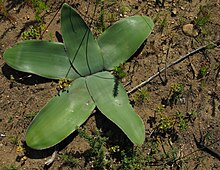
Amaryllis is the only genus in the subtribe Amaryllidinae. It is a small genus of flowering bulbs, with two species. The better known of the two, Amaryllis belladonna, is a native of the Western Cape region of South Africa, particularly the rocky southwest area between the Olifants River Valley and Knysna.
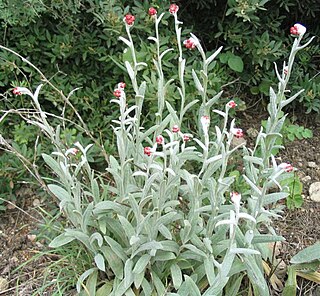
The genus Helichrysum consists of an estimated 600 species of flowering plants in the sunflower family (Asteraceae). The type species is Helichrysum orientale. They often go by the names everlasting, immortelle, and strawflower. The name is derived from the Anicent Greek words ἥλιος and χρῡσός.

Scilloideae is a subfamily of bulbous plants within the family Asparagaceae. Scilloideae is sometimes treated as a separate family Hyacinthaceae, named after the genus Hyacinthus. Scilloideae or Hyacinthaceae include many familiar garden plants such as Hyacinthus (hyacinths), Hyacinthoides (bluebells), Muscari and Scilla and Puschkinia. Some are important as cut flowers.

Haworthia is a large genus of small succulent plants endemic to Southern Africa (Mozambique, Namibia, Lesotho, Eswatini and South Africa).

Massonia is a genus of bulbous perennial flowering plants in the family Asparagaceae, subfamily Scilloideae. It is native to southern Africa, and is found in localities such as Namaqualand with hot and dry summers, being dormant in summer and growing during winter. The genus Whiteheadia has been merged into Massonia. It is classed as a cryptophyte.
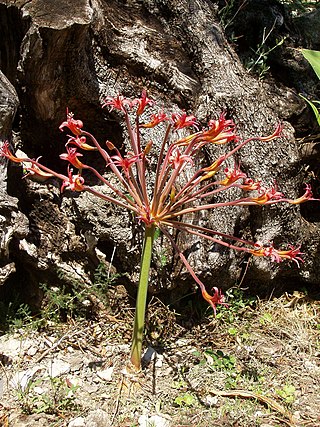
Brunsvigia is a genus of African flowering plants in the family Amaryllidaceae, subfamily Amaryllidoideae. It contains about 20 species native to southeastern and southern Africa from Tanzania to the Cape Provinces of South Africa.
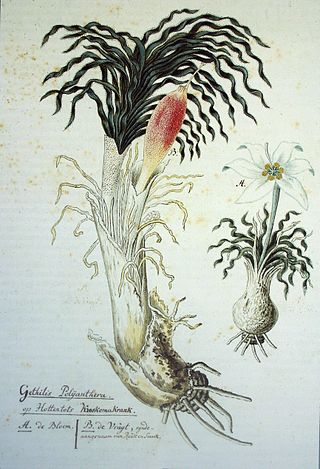
Gethyllis, commonly called Kukumakranka, Koekemakranka, or Kroekemakrank, is a genus of bulbous plant in the Amaryllid family with some 33 accepted species.. It is native to the Cape Provinces, the Northern Provinces and the Free State of South Africa, as well as Botswana and Namibia.

Strumaria is a genus of African plants in Amaryllis family, subfamily Amaryllidoideae. The genus is known in nature only from South Africa, Lesotho and Namibia. Almost all species flower in the autumn and are cultivated as ornamental bulbous plants.
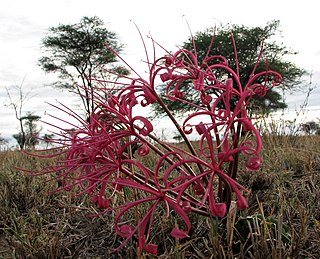
Ammocharis is a small genus from sub-Saharan Africa, in the family Amaryllidaceae which includes seven species distributed in Africa. The plant grows as above-ground bulb, preferring seasonally wet, hot, sandy soils and full sun.

Boophone is a small genus of herbaceous, perennial and bulbous plants in the Amaryllis family It consists of two confirmed species distributed across South Africa to Kenya and Uganda. It is closely related to Crossyne, a genus whose species have prostrate leaves. They are drought tolerant but not cold-hardy, and are very poisonous to livestock.

Ammocharis longifolia is a species of bulbous plant in the family Amaryllidaceae. It has been placed as the only species, Cybistetes longifolia, in the monotypic genus Cybistetes.

Boophone disticha is a bulbous tropical and subtropical flowering plant, endemic to Africa. Commonly called the century plant or tumbleweed, Boophone disticha was first collected in 1781 from South Africa by Swedish botanist Carl Peter Thunberg and described by Carl Linnaeus as Amaryllis disticha. Since that time it has been placed in the genera Brunsvigia and Haemanthus, finally coming to rest as Boophone. The genus itself was written in three ways by the author William Herbert, straining the procedures of the rules of nomenclature. The etymology of the genus is from the Greek bous = ox, and phontes= killer of, a clear warning that eating the plant can be fatal to livestock.
Namophila is a monotypic genus of bulbous flowering plants in the family Asparagaceae, subfamily Scilloideae. The sole species Namophila urotepala is found only in Namibia.

Hessea is a genus of bulb-forming plants in the Amaryllis family native to Namibia and South Africa. The genus name commemorates C. H. F. Hesse (1772–1832), who resided in Cape Town from 1800 to 1817.
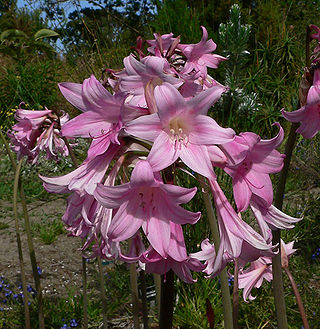
Amaryllideae are a tribe of subfamily Amaryllidoideae. They are herbaceous monocot perennial flowering plants with a predominantly Southern African distribution, with the exception of the pantropical genus Crinum. They are generally treated as consisting of four subtribes. In addition to Crinum, other genera include Amaryllis, Boophone and Strumaria.

Gethyllidinae is a small subtribe within the amaryllis family. It is within tribe Haemantheae, and therefore within the African clades of Amaryllidoideae. It contains two genera, Gethyllis and Apodolirion, both are endemic to southern Africa.
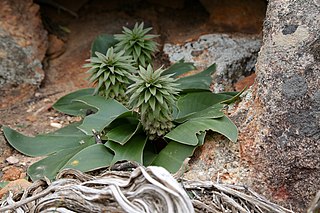
Eucomis regia is a species of bulbous flowering plant in the family Asparagaceae, subfamily Scilloideae, native to the Cape Provinces of South Africa. It is sometimes cultivated, but requires protection in a greenhouse in temperate climates.
Eucomis schijffii is a bulbous species of flowering plant in the family Asparagaceae, subfamily Scilloideae, native to the Cape Provinces, KwaZulu-Natal and Lesotho. It was first described by William Frederick Reyneke in 1976. The reddish purple flowers appear in summer and are arranged in a spike (raceme), topped by a "head" of green leaflike bracts. It is cultivated as an ornamental plant and can be grown successfully outside where frosts are not too severe. The smallest of the species of Eucomis, it is particularly suited to being grown in rock gardens or containers.

Felicia is a genus of small shrubs, perennial or annual herbaceous plants, with 85 known species, that is assigned to the daisy family. Like in almost all Asteraceae, the individual flowers are 5-merous, small and clustered in typical heads, and which are surrounded by an involucre of, in this case between two and four whorls of, bracts. In Felicia, the centre of the head is taken by yellow, seldom whitish or blackish blue disc florets, and is almost always surrounded by one single whorl of mostly purple, sometimes blue, pink, white or yellow ligulate florets and rarely ligulate florets are absent. These florets sit on a common base and are not individually subtended by a bract. Most species occur in the Cape Floristic Region, which is most probably the area where the genus originates and had most of its development. Some species can be found in the eastern half of Africa up to Sudan and the south-western Arabian peninsula, while on the west coast species can be found from the Cape to Angola and one species having outposts on the Cameroon-Nigeria border and central Nigeria. Some species of Felicia are cultivated as ornamentals and several hybrids have been developed for that purpose.
